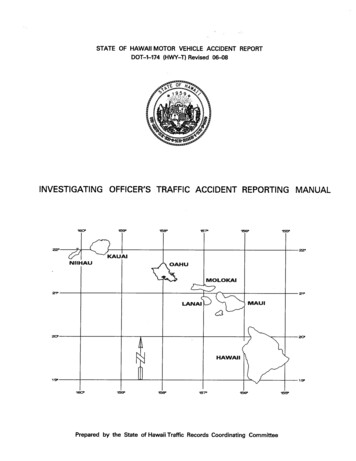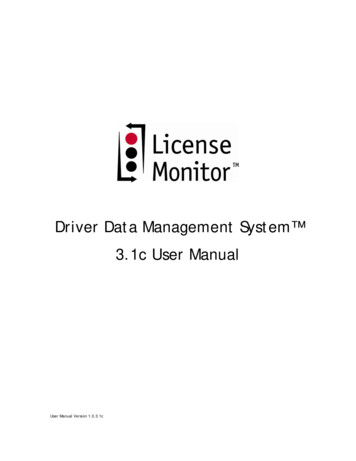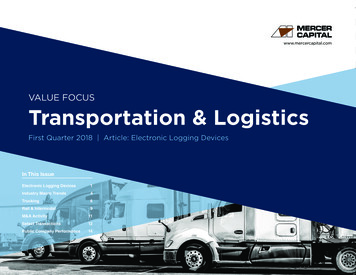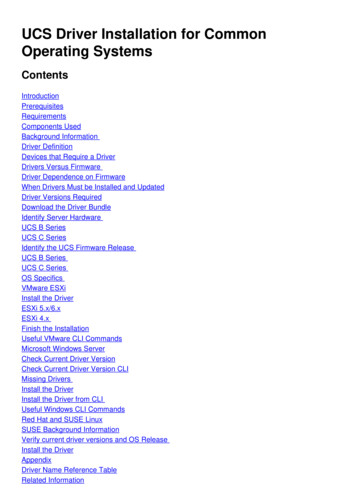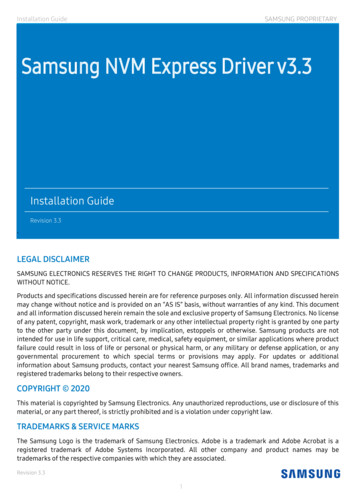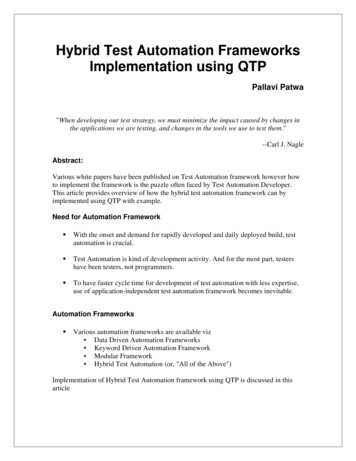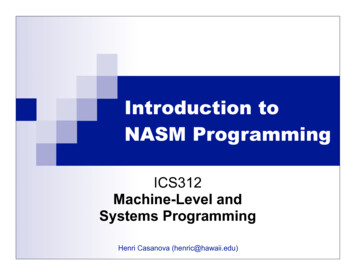
Transcription
Using Technology to Improve DriverBehavior and Increase Fleet SafetyJason Neatrour
Using Technology to Improve DriverBehavior and Increase Fleet SafetyPresented By: Jason F. Neatrour
Using Technology In Fleet Safety:Technology has been used to collect datafor post accident analysis for many years.December 2-3, 2014
Using Technology In Fleet Safety:Post accident analysis is extremelybeneficial.However, by definition, it is reactionary in nature.December 2-3, 2014
Using Technology In Fleet Safety:Post accident analysis allows you to: Analyze collision events after the factin order to identify root causeDecember 2-3, 2014
Video-Based Driver Risk Management :The reaction is to: Put new or improved systems into place Train drivers to avoid these causesDecember 2-3, 2014
Today’s Technology:Today’s technology has evolved to providebenefits which are two-fold:Both Pro-active and ReactiveDecember 2-3, 2014
Today’s Technology:One such technology is:Video-Based Driver Risk ManagementDecember 2-3, 2014
Video-Based Driver Risk Management :Benefits of this technology have evolved tobe Pro-active:After looking at the Root Cause ofcollisions, in many cases it is linked to riskydriving behaviorsDecember 2-3, 2014
Video-Based Driver Risk Management :The key to the Pro-active approach: Identify the risky behaviors in a driver Change these risky behaviors beforethey result in a collisionDecember 2-3, 2014
Based on the Heinrich modelDecember 2-3, 2014
The Pro-active approach: Companies using technology to identifythe risky behaviors that occur will bemore successful in modifying thosebehaviors It is possible to change these riskybehaviors before they result in a collisionDecember 2-3, 2014
Video-Based Driver Risk Management :In a moment we will review actual statisticsfrom a case study: FTS International.December 2-3, 2014
Video-Based Driver Risk Management :Pro-Active Benefits are gained through: Raising driver awareness Allowing management supervision of dailydriving behaviors Increasing driver accountabilityDecember 2-3, 2014
Video-Based Driver Risk Management :How does the system work? The device is triggered by G-Forces Some causes of the G-Forces include: Collisions Hard Braking Sudden swerving or evasion maneuvers.December 2-3, 2014
The Pro-active approach:When a risky behavior is evident: Drivers are coached to change their riskybehaviors Modifying risky behaviors will ultimatelyresult in improved safety of your fleetDecember 2-3, 2014
Video-Based Driver Risk Management :Additional Benefit: Protection from fraudulent claimsDecember 2-3, 2014
Case Study: FTS International A leading provider of well completionservices Currently uses a coaching program alongwith this technology in over 1,500 fleetvehicles.December 2-3, 2014
SampleVideo #1 Snapshots:December 2-3, 2014
Sample Video #1 Snapshots:December 2-3, 2014
Sample Video #2 - Snapshots:December 2-3, 2014
Sample Video #2 - Snapshots:December 2-3, 2014
Sample Video #2 - Snapshots:December 2-3, 2014
Sample Video #3 Snapshots:December 2-3, 2014
Sample Video #3 Snapshots:December 2-3, 2014
Sample Video #3 Snapshots:December 2-3, 2014
Sample Video #3 Snapshots:December 2-3, 2014
Sample Video #3 Snapshots:December 2-3, 2014
Case Study: FTS InternationalUsing this technology along with workablesolutions for coaching has proven to be asignificant benefit to FTS International.December 2-3, 2014
Case Study: FTS InternationalFTSI has: Overcome many driver behavioralchallenges Increased fleet safety Reduced collision eventsDecember 2-3, 2014
Case Study: FTS InternationalToday’s example,Choosing three common risky behaviors: December 2-3, 2014
Case Study: FTS InternationalThree common risky behaviors: Following too Closely Not looking far enough ahead Unsafe cell phone useDecember 2-3, 2014
Case Study: FTS InternationalWithin the first year:Following too closely Improved by greater than %December 2-3, 2014
Case Study: FTS InternationalWithin the first year:Following too closely Improved by greater than 60 %December 2-3, 2014
Case Study: FTS InternationalDecember 2-3, 2014
Case Study: FTS InternationalWithin the first year:Not Looking Far Enough Ahead Improved by greater than %December 2-3, 2014
Case Study: FTS InternationalWithin the first year:Not Looking Far Enough AheadImproved by greater than 50 %December 2-3, 2014
Case Study: FTS InternationalDecember 2-3, 2014
Case Study: FTS InternationalWithin the first year:Cell Phone Use Improved by greater than %December 2-3, 2014
Case Study: FTS InternationalWithin the first year:Cell Phone UseImproved by greater than 50 %December 2-3, 2014
Case Study: FTS InternationalDecember 2-3, 2014
Case Study: FTS InternationalWithin the 3 months immediately followingthe full implementation: 70% reduction in traffic violationsDecember 2-3, 2014
Case Study: FTS InternationalOther benefits experienced included: Reduced vehicular accident claims Fraudulent claims were averted Protected the driverDecember 2-3, 2014
Case Study: FTS InternationalSignificant reduction in vehicular accidentclaim dollars over the prior year: The reduction in claim dollars overthe prior insurance year was%December 2-3, 2014
Case Study: FTS InternationalSignificant reduction in vehicular accidentclaim dollars:66 %December 2-3, 2014
Case Study: FTS International(Confidential values have been removed2014 YTD figure is as of 10/01/2014)December 2-3, 2014
Every company is different, and bothyour challenges and results will vary.December 2-3, 2014
Best Practices:The first steps: Proactively engage a video-based driverrisk management technologyDecember 2-3, 2014
Best Practices:The first steps: Use the presence of video eventrecorders to help build or improve astrong safety cultureDecember 2-3, 2014
Best Practices:Build the best foundation for your program: Safety is everyone’s job Involve your operations team If the operations team is activelyinvolved you will gain the best benefitDecember 2-3, 2014
Best Practices:The core of the program: Coaching Remember, your primary goal is toreduce risky driving behaviors Coaching is the keyDecember 2-3, 2014
Best Practices:The core of the program: Coaching Coach first, but address and correctrisky driving behaviors that don’timproveDecember 2-3, 2014
Best Practices:Track and manage performance: Decide what your Key PerformanceIndicators or KPI’s will be Regularly review the program statusDecember 2-3, 2014
Best Practices:Track and manage performance: If you have multiple locations, usehealthy competition by showing theirsuccessesDecember 2-3, 2014
Best Practices:Make it a positive program: Recognize and reward safe drivingbehavior Inspire drivers to go from feeling “watched”to feeling safer and more protectedDecember 2-3, 2014
References:Risk & Regulation magazineNear-Miss Management:Managing the Bottom of the Risk PyramidUlku G Oktem, Rafael Wong and Cigdem OktemPyramid of AccidentsThe Heinrich modelDecember 2-3, 2014
Thank YouQuestions?December 2-3, 2014
Additional Questions?Contact Information:Jason F. NeatrourSenior DOT Compliance SpecialistFTS InternationalJason.neatrour@ftsi.comDecember 2-3, 2014
The Pro-active approach: When a risky behavior is evident: Drivers are coached to change their risky behaviors Modifying risky behaviors will ultimately
